 |
| Miles Marathon photo courtesy of Wikipedia. |
AIRCRAFT
Decca, in its lifetime, owned a number of aircraft in which Decca products were developed, tested or demonstrated in support of sales. Within the text are quotations from the memoirs of Capt. Peter Huggins who flew several of the Decca Navigator company aircraft as pilot-in-charge. He left Decca around 1970 when his Flight Operations Department was shut down. Peter is 94 in 2008 and is still flying aircraft!
In August 1951, The Ministry of Civil Aviation used a Miles Marathon (four engine, 18 passengers) aircraft in order to promote and brief as many airlines as possible on the Decca Navigator system. So the first aircraft for demonstrating Decca Navigator was not actually owned by Decca. In fact, the Marathon was on loan to MCA from British European Airways for the purpose of Decca demos.BEA considered it obsolete anyway since they were buying Viscounts.
 |
| Miles Marathon photo courtesy of Wikipedia. |
ANSON Mk 19
Peter Huggins recalls the acquisitions of the Ansons. "My first priority on joining Decca in November 1952 was to acquire a suitable aircraft at a reasonable price and arrange for maintenance. We were able to find what we wanted in an Anson XIX, G-AGPB, which we bought from the Ministry of Aviation It had been used for several Decca demos previously and we intended to operate it from Croydon.A deal was cut with a firm called Air Couriers, to do the maintenance and any modifications required for the fitting of Decca Navigator equipment. It was Spring 1953 before the aircraft was completed to our requirements but in the meantime, I spent most of my time at London Airport working from an office there.
The aircraft was fitted with Decca Navigator in the cockpit for me to use and demonstrate, and in the back was a console for demonstrating it to passengers. It was then necessary for me to employ someone as crew member to use and demonstrate the cabin display to customers. The Ministry of Civil Aviation at that time was dispensing with the radio operators in the Flying Unit so they were looking for work. I selected one John Humphrey who had flown with me often as wireless operator. He was looking for a job and was interested in joining the Decca Company.
 |
| When the original Anson aircraft was redesigned to a civil transport specification, it was named the Mk 19 or C.19 when it entered service with the RAF. The second series of aircraft were built with metal wings and tailplane. Maximum speed: 188 mph. Range: 790 mi (Photo courtesy RAF Museum) |
 |
| Decca's first Anson. (From the collection of Walter Blanchard) |
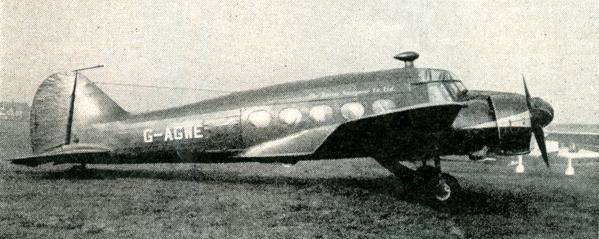 |
| Decca's second Anson. Bought in 1953, it was sold to the London School of Flying at Elstree in 1961 when the Prince aircraft was purchased. (Photo by John W.R. Taylor) |
In that first year, apart from many demonstration flights to airline representatives in the UK, we spent a lot of time in Germany flying the airways between Berlin-Hamburg-Hanover and Frankfurt. These airways were defined by VORs sited at each end. The VOR was then subject to many inaccuracies due to difficulties in siting, resulting in aircraft straying into the Russian Zone and causing endless arguments. The Americans who supplied the VOR equipment swore that there was nothing wrong and the Russians were just making a big fuss. We flew the airways using Decca Navigator and keeping exactly on the centre line. Sure enough, the VOR was wandering all over the place. We were then asked to fly the VOR signals only and leave the Decca flight indicator to trace where we had been. The result was that we were on the verge of infringing upon the Russian Zone!"Unfortunately the first Anson crashed, killing the crew in 1954. The second Anson, G-AGWE, was bought a couple of years after the first one and it operated from Croydon Airport until it closed in 1958. In the interim, the gap was filled by using Ministry of Civil Aviation aircraft which were on loan. Operations were then moved to the former WWII airfield at Biggin Hill and remained there until the aircraft was sold in 1960.
Peter Huggins reports that "In the late 1950s, the company received a contract to develop Doppler equipment for the RAF and in order to carry out airborne trials it was necessary to have a larger aeroplane as the Anson was not capable of carrying all the gear along with the engineers required for evaluation. The Ministry of Supply agreed to loan us a Valetta, so I went down to Boscombe Down to be checked out in the type and was immediately placed on the approved list of Ministry of Supply test pilots. In due course, we were allotted a Valetta and I went up to Pershore to collect it. I flew it down to Croydon where it was fitted with the Decca Doppler by Air Couriers and Doppler trials began. Croydon was not a suitable field to operate the Valetta, Since Air Couriers had now established a base at the ‘new’ Gatwick Airport we moved our base of operations there.
 |
| 1958 to 1963: The Vickers Valetta 1, which was originally equipped to carry 36 paratroopers, was based in Malta with the RAF between 1951 and 1968. Maximum speed: 224 knots (258 mph, 415 km/h) at 10,000 ft .Range: 1,270 nm (1,460 miles, 2,350 km). In 1963, Decca's Valetta G-APKR (s/n) 338), crashed at Gatwick Airport due to an undercarriage failure but luckily there were no casualties. (From the collection of Walter Blanchard) |
Since the loan agreement of the MoS Valetta was due to lapse, we arranged to buy two Valettas from the MoS and I collected these from Pershore and Boscombe. One was cannibalized for parts to improve the other and then put on the Civil Register - the first and only civilian Valetta. Having so much more room and payload than the Anson, it was fitted out as a flying laboratory with several different types of Decca Navigator and Doppler equipment. With this aircraft we were now able to undertake longer trips with more people on board and had several long demonstration sessions in Berlin, Rome, Warsaw and the Scandinavian countries.At the end of September 1963, we had an accident with the Valetta which was not our fault. On returning from a flight I landed normally at Gatwick, light as a feather. Near the end of the landing run, the starboard undercarriage collapsed for no apparent reason. Our engineers could find no reason for the failure. I reported the accident to the Air Ministry and was told that this had happened before on several occasions but even they did not know why. The registration was cancelled on 16 October 1963.
In a way the accident did us a lot of good as we did very well on the insurance money which enabled us to eventually get a much better aircraft - the Airspeed Ambassador".
AIRSPEED AS57 AMBASSADOR 2
Peter Huggins provides some background on the Ambassador aircraft. "George Errington, who I had known before the war, was a great supporter of Decca, so he suggested that we acquire an Airspeed Ambassador. He had been the test pilot for Airspeed and knew the Ambassador inside out. British European Airways had used them until the Viscount was phased into service so he had kept track of their whereabouts. He told us that King Hassan of Morocco was disposing of his Ambassador in order to buy a turbojet. George thought it could be had at a reasonable price if we left the negotiations to him. We were glad to do this and in due course, Mike (another pilot) and I flew out to Rabat to collect the aircraft. It is belioved that the aircraft was acquired for as little as £3000. George Errington came with us since none of us had the type approval on our licences. We took a Dan-Air pilot, Bob (Sport) Martin, to check us out and keep us legal. The aircraft then went into Air Couriers for about six weeks where it was fitted with all the racking and cabling required to take the Decca display in the cabin areas and the cockpit.
Behind the cockpit was a large space for luggage; behind that was a cabin for eight lesser mortals; behind that again was the Royal suite consisting of two large armchairs and a long bench opposite; behind that was a WC (washroom) for men and a ladies’ powder room with full size mirrors. We disturbed the layout as little as possible. The luggage bay was fitted out as a laboratory with various power supplies and aerial sockets for experimental work. In the front cabin, a console was installed to take any form of Decca we wished to demonstrate. The ‘Royal Suite’ was fitted with a console between the two armchairs for demonstrating the equipment to Decca's most important customers. In the cockpit we had three different Decca displays and room for a fourth behind me at the old Radio officer's station.
Originally the Ambassador had been designed as a 54 passenger transport, and I believe that some charter companies fitted seats for as many as 60 people. The maximum we could carry including crew was seventeen, so even with the weight of the various equipment we carried,. we never reached maximum permitted weight except on the one occasion when we took the aircraft to America.
On September 23, 1964 the Ambassador aircraft left for a United States tour. After our multistop flight from Gatwick we cleared Customs and Immigration at Idlewild Airport in NYC (now called JFK) and were then instructed to take the aircraft over to La Guardia Airport. a very short hop away. After landing at night, we taxied out the next day in daylight and in the process we created some excitement. In the ensuing chatter, someone finally said “What is it?” No one in the US had ever seen an Ambassador before so it caused quite a stir. They did not know what to call us and they had never heard of the manufacturer called Airspeed. Since the design had been taken over by de Havilland, which they had all heard of, and the registration of the aircraft was G-ALZP, we became known on the airway as de Havilland Zee Pee".
The Ambassador, which operated out of Gatwick, ran into "business" problems. It was stationed at the General Aviation terminus (now long gone) but the Ambassador was occupying a disproportionate amount of space just being parked there and was not providing enough throughput of passengers. So the Gatwick General Aviation manager told Peter Huggins either he increased "trade" considerably or he would have to go. There was also a problem servicing such a large aircraft elsewhere. The alternate airfields (West Malling and Biggin Hill) had no suitable servicing or hangers available. Peter couldn't move there so the operation collapsed.
Someone made an offer to purchase the Ambassador in 1971. Ray Kinkaid of Decca serviced it and did two test flights. A few years later it was broken up for scrap.
In March, 1964 Decca bought an Airspeed Ltd, Ambassador aircraft s/n 5213 from the King of Morocco, G-ALZP. Originally in service with British European Airways, the aircraft had a cruise speed of 272 mph and a range of 720 miles. (From the collection of Walter Blanchard) The Ambassador is on the way to the Farnborough Air Show in 1966. It was originally CN-MAK when registered in Morocco before Decca bough it. (From the collection of Walter Blanchard) G-ALZP at Templehof Airport, Berlin on June 19, 1969. (Photo by Peter Seeman, Airliners.net)
Decca's Percival Prince 2A, G-ALWH, had quite a history. It was delivered brand new to the Shell Refining and Marketing Co Ltd in 1950 and immediately flown (alongside G-ALWG) to Compania Shell de Venezuela where it was registered YV-P-AEO in April 1950. It flew back to Britain in December 1952 and was re-registered G-ALWH with Shell who operated it in Seria in Brunei. It returned to the UK again and was sold to the Sperry Gyroscope Company in December 1954. In April 1961 it was registered to Air Couriers (Transport) Ltd of Biggin Hill but never flew for them. The Decca Navigator Company Ltd then acquired the aircraft in July 1961 and based it at Biggin Hill. It last flew as G-ALWH, Cranfield to Biggin Hill with pilot Poulter on 29th August 1974, after landing it had total flying time of 5423 hours. In 1975 it was advertaised for sale but nobody wanted it until it was sold for scrap value (£600) to Bob Garretson of CaliforniaIn in July 1976. He replaced one engine, fixed it up and registered it N206UP. It departed Biggin Hill for the last time on 28th March 1977 enroute to Van Nuys in California. It rarely flew and passed through many owners until it was dumped at Van Nuys while owned by James di Giusseppe. In late 2008 it was donated to Frank Motter (trading as the Thunder Air Museum) at Lancaster, CA. It was dismantled and moved to Antelope Acres where it remains in one piece but unwanted in 2017. Frank would love it to be returned to the UK but its not a warbird so sadly there is zero interest. Only one other short-nose Prince survives - G-AMLZ at Liverpool Speke Airport. In the December 1973 issue of Decca Navigator news, there was a feature story describing the Biggin Hill operation and showing the Prince aircraft still in full use.- G-ALWH was built as a Prince Mark 1 and according to the Registration Documents , it was converted to Prince Mark 2A by 26 Feb 1953.
- Under Decca ownership, the crew of this aircraft was Captain Bill Poulter (now deceased) .Ground staff Gordon Ohlson and Bob White.From the aircraft's log book:
29 Aug 1974 Last flight (2 hour 10 min) as G-ALWH. Total time 5423 hours.
17 July 1975 Put up for sale and advertised in “Flight International”.
1976 Many instruments removed. Metal bits discovered in the oil of one engine.
The aircraft was then stored at Biggin Hill awaiting a decision to scrap it.6 July 1976 Bought for £600, (which Decca said was scrap value), by Robert D. Garretson,
1415 North Dearborn, Suite 26B, Chicago IL 60610 .USA. Decca paid for hangar
charges while work carried out. Aircraft Bill of Sale signed by Poulter, Manager
Flight Operations, Decca Navigator. Garretson wanted to “fix it up and fly it around”.
Bought engine from Coggins’ Prince (G-AMLZ) for £2,200 to replace damaged/time
expired port engine and swapped them. G-AMLZ is now preserved at Liverpool
Airport.Registered as N206UP in USA
28 March 1977 The aircraft departed Biggin Hill; flown by Garretson with a crew and passengers via Luton (stuck on grass – pulling away -engines caused oil damage to parked cars!)- Stornoway – Vagar/Faroe Islands 29.3.77 (should have been direct to Iceland but strong winds caused change of plan) – Reykjavik – Kulusuk – Sondrestromfjord – Frobisher Bay –Fort Chimo – Thunder Bay – Chicago (US Customs at Chicago were not convinced that the plane was legal. The total expenditure for the aircraft and all expenses seemed too small. All documents shown to FAA and the flight continued. Two waitresses picked up for the ride to CA) – Grand Junction – Santa Monica –Van Nuys
Several owners and very little flying saw it dumped at Van Nuys until dismantled and moved to Lancaster CA in 2009.with new owner Frank Motter.
In the December 1973 issue of Decca Navigator news, there was a feature story describing the Biggin Hill operation and showing the Prince aircraft still in full use.
 |
| 1961 to 1974: The Percival Prince normally had an extended nose to accommodate an observer - photographer but Decca had the short-nosed version. This aircraft has an endurance of 6 hours flying time and a range of 1600 km. Decca's Prince was registered as G-ALWH (From the collection of Walter Blanchard) |
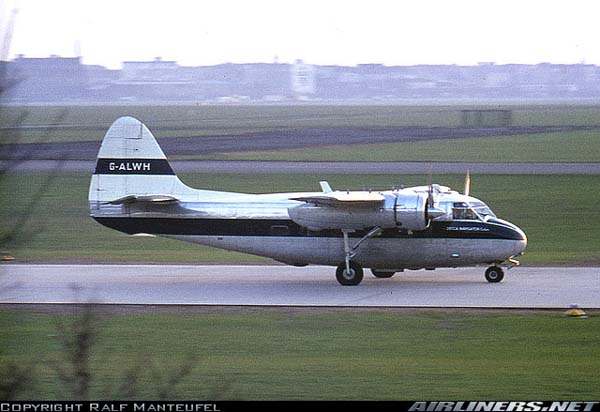 |
| G-ALWH at Templehof Airport, Berlin on April 21, 1969. (Photo by Ralf Manteufel, Airliners.net) |
Walter Blanchard comments on the Prince aircraft. "'We thought G-ALWH was a huge improvement over other aircraft - it actually had an elementary cockpit heater! This aircraft was also used by Sir Edward Lewis, Chairman of the Decca Group as an unofficial personal taxi . He would sometimes ask us whether we had thought of flying up to Manchester (or similar location) to watch the cricket Test Match, and if so might he come with us? We got the message!The last time I heard of this Price aircraft was in 2001 when I was in California. It was parked at Van Nuys Airport having been sold to an American historical aircraft buff. I had some correspondence with the owner who offered to sell it back to me for $USD 5,000. It was the last known example in existence which had the short nose. What happened to it subsequently, I don't know"
 |
| N206UP still carries Decca markings on its nose but one needs to be up close to see it. (Photo source and date unknown at this time) |
 |
| N206UP as the aircraft appeared in 2016. (Photo by by Frank Motter) |
BELL 47-G HELICOPTER
To facilitate the development of lightweight airborne equipment, particularly that destined for helicopters, Decca acquired a Bell 47-G helicopter from Worldwide Helicopters in 1966 It was used mainly for Decca Mk 15, 19 Doppler 71 and later for Data Link development and testing.
That helicopter was a three seat model powered by a 200 hp Franklin 6V4-200-C32 engine which gave it a cruising speed of 70 knots and an endurance of 2.5 hours. It was equipped with full night flying equipment and a modified instrument panel which included a lightweight artificial horizon, heading indicator and a hovermeter. In the mid 60's it was fitted with a Mk 8 Navigator receiver, a flight log, and a well as a series 70 light-weight Doppler. During this time period it was also used in the development program for the Doppler 70 series, Doppler 80 series and the Mk 15/19 Decca Navigator.Decca Doppler for helicopters was proving to be of great interest to everyone in that particular field so Decca did a lot of demonstrating. The receiver aerial was no more than a foot from the ground and without even flying, one could slide along the grass and get a reading of half a knot or less. The output was coupled to a speed meter and a cross pointer meter so that it was even possible to hover blind.
Peter Huggins relates this flying anecdote. "In May of 1966 I was bringing the helicopter back from the Air Show at Hanover in a howling South West wind. It was a slow progress having flown from Hanover to Osnabruk to Nornhorn to Hilversum. From Hilversum to Rotterdam was dead into gale force winds and it took me one hour and fifteen minutes to fly a distance of 35 miles. I was flying as low as I dared to get the lowest head wind possible when something caught my eye below and I found that I was being overtaken by a frightened cow! I was almost stationary at the time".
Peter flew the helicopter occasionally but the main pilot was Edward A. Hood, also known by the nickname of "Robin Hood.” Edward was a pipe smoker and would sometimes puff away when flying, much to the chagrin of any passenger. It is not known how long Decca kept the helicopter but the Civil Aviation Authority records indicate that G-ARIA was registered to the Arabian Aircraft Corporation in Brighton in May, 1984. By March 1987 the Bell 47-G was and transferred to France since the C-of-A expired in February 1986.
 |
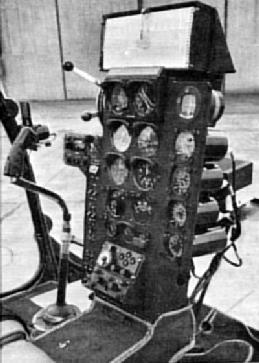 |
| 1966 to 1984(?) Bell Aircraft 47G helicopter G-ARIA s/n D6 built in 1947. By 1982 it had 6,608 hours on the airframe. Note the Decca name on the fuel tank. | The helicopter's instrument panel with a flight recorder atop. |
| From Decca Navigator News - February 1966 (From the collection of Walter Blanchard) | |
JETSTREAM 1
Around 1974, Decca's Percival Prince was replaced by a modern, pressurized, twin turbo-prop 'Jetstream' aircraft, G-AWVK (Victor Kilo). The HP-137 Jetstream was initially designed and built by the Handley Page company as a high performance, economical corporate aircraft or 'commuter' airliner. After Handley Page succumbed to bankruptcy problems in 1970, their interests were assumed by a collaboration of investors who formed Scottish Aviation . Scottish Aviation eventually went bankrupt and was merged into British Aerospace in 1978.Victor Kilo was first sold to a short-lived airline in the United States in 1969. It was ferried to California but was never put into service, and was subsequently flown back to the UK. Apart from a few demonstration flights for its sale, it was not used again until it passed into Decca ownership. By then, the total flying time amounted to little more than the hours accumulated on the ferry and demo flights.
Dick Caddy, the last employee of the Chain Department who effectively closed the system down in the UK and shut the door of Wymondly behind him, recalls the Jetstream. “I was at Biggin Hill on or around the day the Jetsteam arrived and its livery was that of Cal-State Airlines which was only in existence from 1968-1970. Two engineers at Biggin Hill stripped the aircraft completely apart, down to every last nut and bolt and rebuilt it. The engines went back to France for overhaul. We used to join these two chaps at Biggin for a cup of tea quite frequently so were always up to date on progress. One of my visits to Biggin happened to coincide with the maiden flight and I was asked to join them but politely declined saying something like......"no, not having seen what you two buggers have been up to!"
Powered by two Turbomeca Astazou engines, the Jetstream has a cruising speed of around 230 knots (265 mph). Its pressurized cabin permits a cruising height of some 20,000 feet. above the worst of the weather. Weather radar was installed so that storm clouds which extend through the cruising level could be avoided. In addition the aircraft is protected by full anti-icing equipment and was equipped with a comprehensive range of navigational equipment. It could thus operate in all but the very worst weather conditions.
Taking pride of place on the central instrument panel was the Decca Danac pictorial display driven by the Navigator Mk 15 receiver. Space had also been allocated alongside this for the TANS computer which along with Doppler 72 was fitted later. An ADL 81 automatic Loran C receiver was also installed. This equipment was installed for specific flights which extended into areas of Loran-C coverage. The control and display unit were fitted in the co-pilot's instrument panel.
The Decca tradition of a roomy, full standing-height cabin as in the previous Valletta, Ambassador and Prince aircraft was maintained. This permitted comfortable seating accommodation for 12 passengers, although up to 17 passengers could be carried if the need arose. For airborne trials or demonstration of Navigator Company equipment some of the seats were replaced by tubular steel 'rigs' which supported shelves upon which the equipment was mounted. Initial development flying could thus be carried out without prejudice to the basic operation and navigation of the aircraft, but the trials equipment could be progressively interfaced with the aircraft systems and displays as development continued.
While its primary purpose remained that of development and sales demonstrations of Navigator Company equipment, it was not surprising that the use of such a sophisticated aircraft was extended to other divisions within the Decca Group. Its operating economy made it competitive with airline travel when three or more people were required to travel together. The removal of some or all of the passenger seats permitted the carriage of up to 1,500 lb of freight.
The aircraft was regularly used in the exchange of rig crews to the Ekofisk field in Norway. Crews were flown
from Norwich to Stavenger where they continued the journey to the rig by helicopter.
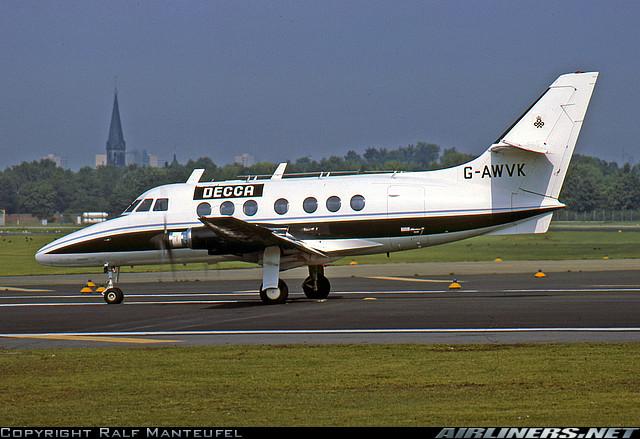 |
| February 1974 to December 1986 (as AWVK): Decca's Handley Page HP137 Jetstream aircraft "Victor Kilo". It was Jetstream series 1 [note 1], serial number 208, built in 1968. Registered as G-AWVK in February 2, 1974. Here the aircraft is pictured at Templehof Airport in Berlin on August 30, 1979. (Photo by Peter Seemann) |
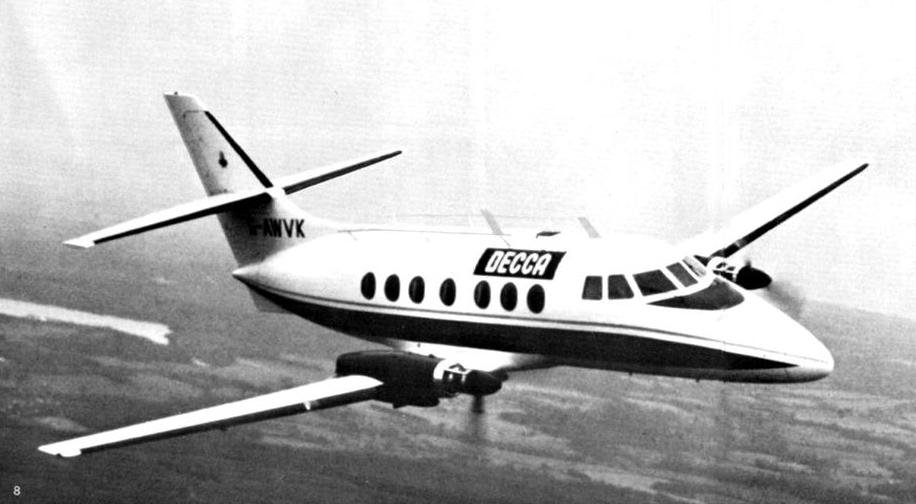 |
| Jetstream in flight. (From the collection of Walter Blanchard) |
 |
| 1980: Soon after Racal took over Decca both company names appeared on the fuselage. Pilot Bill Poulter is on the extreme left while his co-pilot, Phil Stokes, is on the extreme right. In between are Racal personnel. (Decca Navigator News, September 1980 from the collection of Walter Blanchard) |
 |
| 198(?) to 1986: G-AWVK has been repainted in Racal livery and the Decca name has been dropped. Note the distinctive wing pods which have been added. (Photo by Bill Sheridan) |
 |
| In December 1986, G-AWVK was de-registered by Racal and re-registered as G-RAVL by the Cranfield College of Aeronautics By December 31, 1993, the aircraft has accumulated nearly 4,275 flying hours. G-RAVL was permanently deregistered in January 2001. The aircraft saw service with the Decca group for some 27 years. (Photo by Malcolm Clarke) |
Roger Bailey of the Cranfield College provides the final chapter of Victor Kilo's story. "Cranfield did buy G-RAVL from RACAL (in 1989 I think) I flew it on an avionics trial here in the early 90's on a lease back arrangement with Racal. Phil Stokes was the company contact man in those days. Sadly the aircraft arrived
with time on the engines engines nearly expired. The college could not find the required £300,000 to replace them so the aircraft was retired. It is still here in 2008 but now being being used during the Accident Investigation course. It is still in one piece but it can be arranged on the airfield as a supposedly crashed aircraft for the
students taking the crash investigation course.Our current Jetstream, G-NFLA (ex-G-BRGN) , is a J31 with Garrett TPE 331s as opposed to the G-RAVL which was a 200 series fitted with Astazou XVI engines."
HS-125
The Hawker Siddeley HS125 was the last of Decca-Racal's aircraft. Originally built in 1984, it was registered as G-RACL (s/n 257212) in March 1984 to Racal Avionics Ltd., Western Rd., Bracknell Berkshire.Turbo props are fairly economical to operate at low altitudes unlike a pure jet which likes to fly at maximum altitude for best fuel economy. It is therefore believed that the role of G-RACL was more of a corporate jet than a test bed for the company's avionics products.
David Jones comments. "During its short span of service, the HS125 may have been more of an executive jet than flying lab. During that period in the Decca group's history, there were some major events taking place. Racal had just been awarded a license to provide the second national UK cellular service (Vodafone) in order to compete with the incumbent British Telecom system. That was a massive leap forward by a hitherto little known electronics group. This spurred some serious advertising spending by the group to promote the company name. Also during this period, Racal Avionics was teaming up with GTE Airfone to offer satellite based aircraft phone service to all. By coupling the expertise of Racal Antennas with Racal Avionics, a fully integrated system could be pitched".
The HS125 was de-registered in August 1986 when it was transferred to the USA likely as a cost cutting measure.
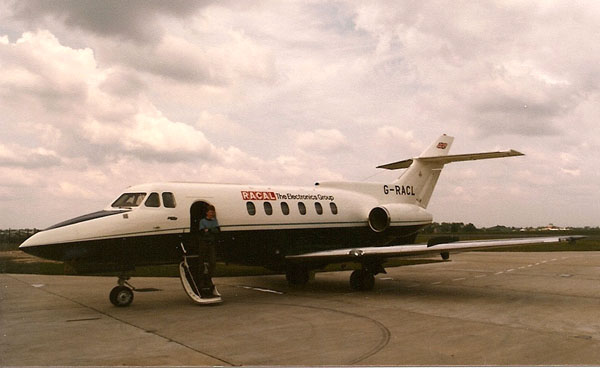 |
| This Hawker Siddeley (now BAE) HS-125-700B, was used by the Racal Group. (Photo by Clive Baker) |
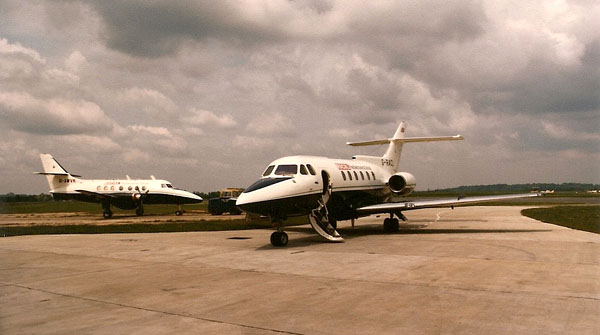 |
| The Jetstream (left ) and HS-125 in company. (Photo by Clive Baker) |
VESSELS
M.V. NAVIGATOR (Both old and new)Ever since the launching of the Decca Navigator System for peacetime use, a demonstration yacht has been the centre of Decca's sales policy. The first yacht used by Decca in 1946 was named the ABEDONIA. Shipowners and the Press were constantly astonished on those early demonstrations when previously computed readings of buoy positions came up on the decometers exactly at the time of passing the buoy.
It was soon found that a larger vessel was necessary so in 1947, a 72 foot Harbour Defence Motor Launch was purchased from the Admiralty and name M.Y. NAVIGATOR. After 18 years service, it was decided to replace the old vessel with a new one and reuse the name. During her service, the old yacht steamed some 1,000,000 nm and demonstrated Decca's marine equipment in most ports of N.W. Europe. Her list of visitors was long and illustrious including royal navigators Prince Philip and King Olaf of Norway. The retirement of the vessel severs a link with the early days of Decca in the marine world.
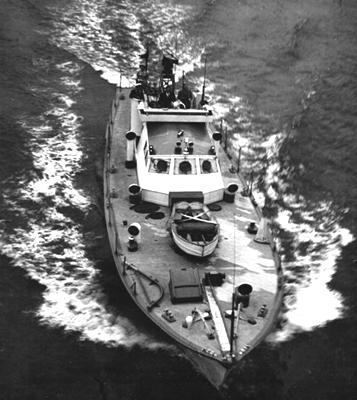 |
| The old M.Y. NAVIGATOR passing under London's Tower Bridge during the BBC broadcast on Saturday 21st September 1949 when a commentary was given on a radar controlled run upstream. Inside the blacked-out wheelhouse, Group Captain Fennessy and Lt. Cdr Coles monitored a Decca Navigator and radar. The instruments exclusively guided the vessel in a crowded waterway while running at 12 knots. The commentators were Charles Gardner and Henry Riddell who can (barely) be seen on the bridge with the Skipper. The helm was unmanned throughout the entire run! (From the collection of Walter Blanchard) |
 |
| Another view of the old M.V. NAVIGATOR at the right and her bridge in the left photo. (From Decca Navigator News, Feb 1966) |
The new M.Y. NAVIGATOR was larger and better fitted for undertaking extensive overseas sales tours. She was purchased from the famous yard of Camper and Nicholsons Ltd. Vosper stabilizers were fitted – a refinement which was appreciated by both visitors and crew particularly on a rough passage. The vessel was equipped with an extensive range of Decca Marine products. These include Decca Navigator Mk XII Multipulse receivers/trackplotters, Hi-Fix equipment including the provision for the erection of a Hi-Fix transmitting station for use in conjunction with shore slave stations. Also on the manifest was Decca radar equipment which featured the Transar range 12 in. True motion, 9 inch Relative motion and 12 inch high definition displays with four and six foot slotted waveguide antennas plus the D202 radar. Other products included the Simrad navigational echo sounder type EP 2BN Panel mounting, and type ES 2BN bulkhead mounting, For river navigation, there was a Decca rate of turn indicator. M.Y. NAVIGATOR also carried the latest transistorized ARKAS Automatic Pilot operated from gyro control and the new (at the time) ARKAS remote-control Magnetic compass unit.
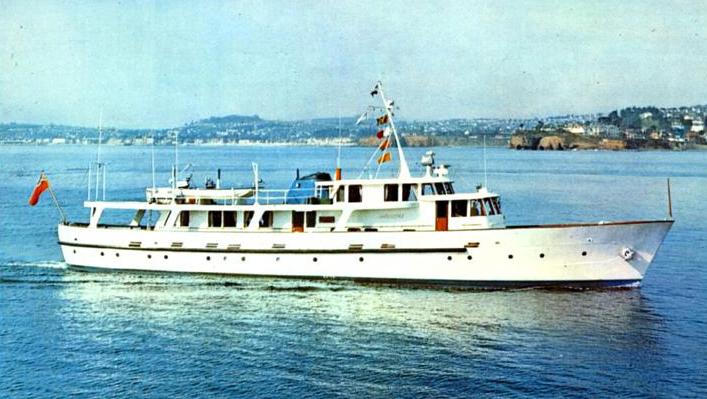 |
| The new M.V. NAVIGATOR. It is believed the yacht was acquired around the 1964-65 time frame. (Decca photo from the collection of Walter Blanchard) |
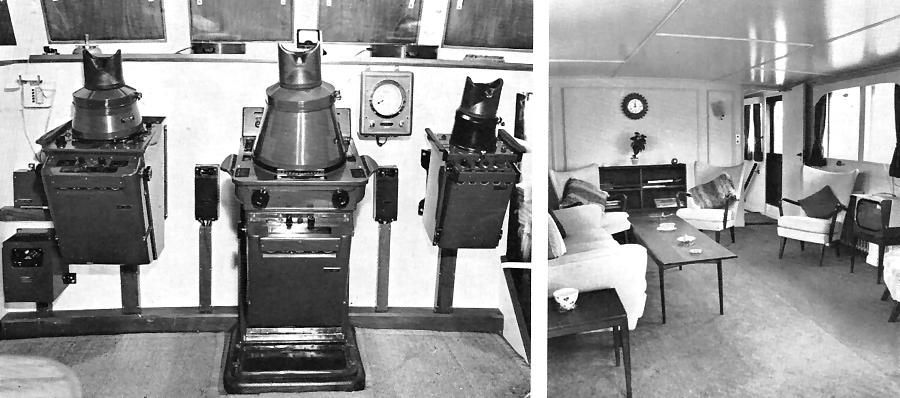 |
| Radar displays on the bridge and what appears to be a lounge in the right photo. (From Decca Navigator News, Feb 1966) |
 |
| Various Decca Navigator demo sets. (From Decca Navigator News, Feb 1966) |
M.V. NAVIGATOR (NEW) SPECIFICATIONSOverall length: 102 feet
Beam: 17 feet , 9 inches
Speed: 12.5 knots
Range: 3,000 miles art 10.5 knots
Propulsion: 2 x Gardner diesels Type SL3B ; 230 hp each at 1,150 rpm
Displacement: 120 tons ( Thames displacement) [Note 2] 140 tons load displacement.
DECCA SURVEYORUntil the Decca Navigator system became commercially available in 1945, hydrographic surveys were still using the same equipment and techniques that Captain James Cook had used almost 200 years earlier - hand lead and line and horizontal sextant angles. Decca proved to be a breakthrough for the industry and the creation of special two range Decca systems that further increased its accuracy made it an invaluable tool that brought immediate benefits to the productivity and quality of hydrographic surveys. When DECCA SURVEYOR entered service in early 1972, she joined a fleet of four vessels engaged in the exploration and production of oil and gas in the North Sea. Although she was not a sales demonstration tool, it would be appropriate to include her in this section of the document.
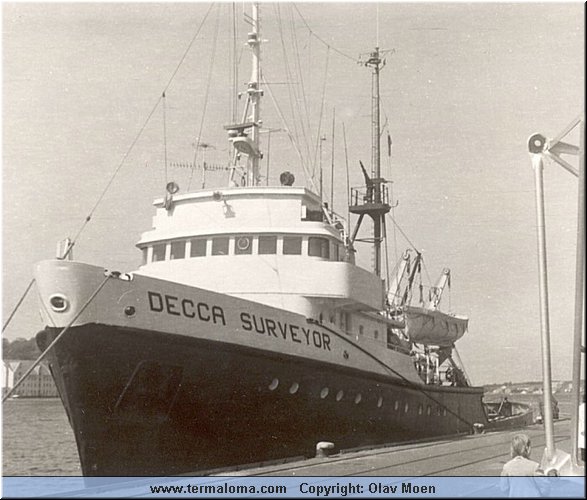 |
| The Decca Surveyor vessel (568 grt) in April 1972, was probably the most comprehensively equipped and versatile survey vessel in operation in European waters at the time and was engaged in the exploration and production of oil and gas in the North Sea. The ship was based in Great Yarmouth, UK. (Photo by Olav Moen) |
UBEROUSThe dictionary defines the word "uberous" as either fruitful, copious; abundant or plentiful. Hopefully the vessel lived up to its name and there were many Decca Navigator demonstrations aboard.
 |
| "UBEROUS" - the Decca demonstration vessel which was based at Brixham, UK. (From the collection of Walter Blanchard) |
 |
| Vicky Molloy-Vickers in the wheelhouse of the UBEROUS while the vessel was docked at Dartmouth, UK in 1965. In evidence, is the Mk XII decometer bowl in the centre of the photo. (Photo by John Molloy-Vickers) |
OTHER
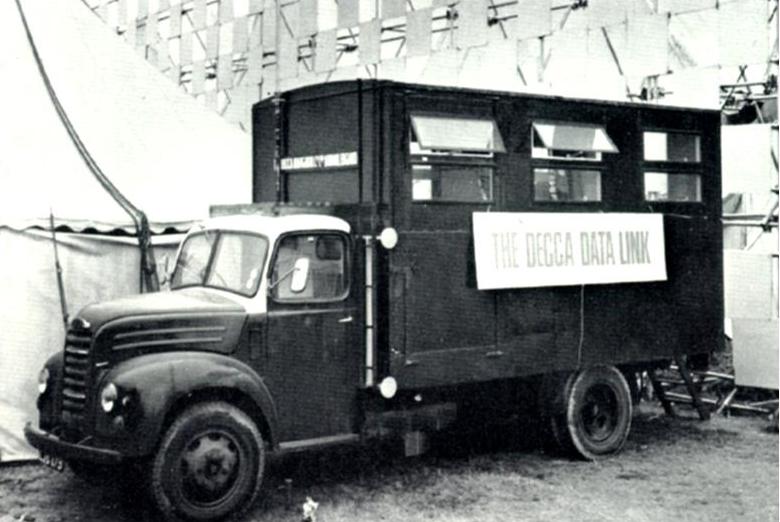 |
| Early in 1958, the British Air Ministry signed a contract with Decca
to develop a Data Link product which would faithfully display the
instantaneous positions of a number of aircraft ar the ATC Centre. A demonstration/development
truck featured the first model of the Decca Data Link.
This truck was based at Biggin Hill and it was taken to one of the Farnborough air shows. The photo is believed to have been taken in the 1960's. (From the collection of Walter Blanchard) |
Notes:[1] The British Civil Aviation Authority on-line database lists the aircraft as a Series 200 with TURBOMECA Astazou XIVC1 engines. This is puzzling because the series 200 is supposed to be fitted with the type XVI engines according to the description in Wikipedia. Series 1 used the type XIV engines. A hard copy of the registration shows Victor Kilo started as a Series 1 then became a Series 200 but the date of this occurrence is illegible and no details were provided. The engines remained as Type XIV. Cranfield College cleared the discrepancy by confirming that the aircraft had the XVI engines. It would appear that there was an omission made by CAA for Victor Kilo. When the Series was updated from 1 to 200 , someone neglected to show the engines were upgraded from type XIV to XVI. Mystery solved.
[2] "Thames Measurement Tonnage" is an approximate representation of the internal capacity of a yacht derived from a system of measurement adopted by the Royal Thames Yacht Club in 1854. The rule for computing the Thames Measurement tonnage is as follows:- From the length (measured from the fore side of stem to the after side of sternpost on deck) deduct the breadth, multiply this result by the breadth, and that product by the half breadth, divide by ninety-four. This tonnage appears in the Register in the case of every yacht, where these dimensions are known, and is printed below the official tonnages where these tonnages are given.
Credits or References:1) David Jones <djones(at)litramfg.com>
2) Santiago Insua <hwasp(at)hotmail.com>
3) Decca Surveyor photo by Olav Moen. http://www.termaloma.no/Gal62/imagepages/image7.html
4) Anson C19 photo http://www.rafmuseum.org.uk/raf-museum-collection.cfm
5) John Molloy-Vickers <johnmv(at)sympatico.ca>
6) UK Civil Aviation http://www.caa.co.uk/application.aspx?catid=60&pagetype=65&appid=1&mode=searchnoresult
7) HS125 photo http://aviation-safety.net/photos/displayphoto.php?id=19960118-0&vnr=1&kind=PC
8) Miles Marathon photo http://en.wikipedia.org/wiki/Handley_Page_Marathon
9) http://en.wikipedia.org/wiki/Handley_Page_Jetstream
10) Second Anson photo from Meccano Magzine March 1957
11) Victor Kilo May 1975 issue of Decca Navigator News
12) Roger Bailey <R.Bailey(at)Cranfield.ac.uk>
13) Walter Blanchard <wb(at)g3jkv.co.uk >
15) Peter Seeman
16) Malcolm Clarke
17) Clive Baker son of David Baker . e-mail <CBaker(at)kaba.co.uk>
18) Tom Singfield <tomsingfield(at)gmail.com>Oct 29/18